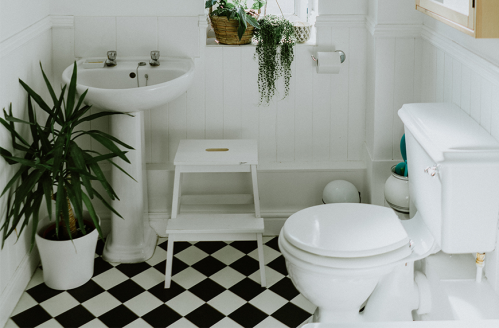Our editors independently select these products. Making a purchase through our links may earn Well+Good a commission
Here’s every dirty detail you need to know about ‘toilet plumes’—and how to keep poop off your toothbrush
Flushing with the lid down has a huge impact on the cleanliness of your bathroom. Here's what the you need to know about "toilet plumes."

There are two types of flushers: those who flush with the lid up and those who flush with the lid down. For some people keeping the lid down is a matter of aesthetics, but it also has a huge impact on the cleanliness of your bathroom. Flushing with the seat up leads to “toilet plumes,” an aerosolization of everything (and I mean everything) in your toilet, explains microbiologist and author of The Germ Files Jason Tetro.
“Plumes are the same as droplets that you cough and sneeze out,” says Tetro. “Once emitted, they will deposit on any surface that happens to be within a few feet of the toilet.” That means if you’re a seat-up flusher and opt for open storage, your toothbrush, eyelash curler, and towels all probably have traces of fecal matter on them.
Scientist have known that flush toilets produce bioaerosols since 1955. And over time, many different types of flush toilets have been created, but they all release plumes. A 2013 toilet plume research review shows that flush toilets produce “droplets small enough to be inhaled deep into the lung, and that these bioaerosols may remain viable in the air for extended periods.”
How toilet plumes impact your health
“It seems that plume can be a possible source for infection,” says Tetro. “In terms of bacteria, it’s not really all that important. However, when it comes to viruses, it’s a different story. Norovirus is the most likely candidate for this spread but SARS may have also spread this way.”
If your brain went straight to COVID-19 while reading that, you’re not alone.
“As for COVID-19, there is some evidence that the virus can survive in the stool, but so far there has been no indication that the concentration is high enough to pose a risk,” says Tetro. “Whether it’s norovirus, E. coli, or COVID-19, I think you should be less concerned about the name of the pathogen and just do your best to avoid exposure to any of them.”
Ways to avoid toilet plume exposure
The best way to avoid plumes is simple: close the lid. For a study on toilet plumes, researchers “seeded” a toilet with fecal suspensions of C. difficile, a bacterium that causes diarrhea and colitis, and found widespread dissemination of large droplets when the toilet was flushed with the lid up, but not with the lid down. “C. difficile was recovered from air sampled at heights up to [10 inches] above the toilet seat and up to 90 minutes after flushing, at concentrations 12-fold greater with the lid up than with the lid down,” the study reads.
If you find yourself in a public bathroom where there is no lid, Tetro says there are some steps you can take to protect yourself.
“If you’re concerned about the contamination of the paper and/or seat from toilet plumes when you’re using a public toilet, just remember that the risk will come from your hands,” he says. “So, even if you haven’t touched anything biological on your visit, make sure to properly wash your hands so you don’t end up coming into contact with an unwanted microbial invader.”
The next time someone asks you to put the seat down, just do it, okay?
Sign Up for Our Daily Newsletter
Get all the latest in wellness, trends, food, fitness, beauty, and more delivered right to your inbox.
Got it, you've been added to our email list.









